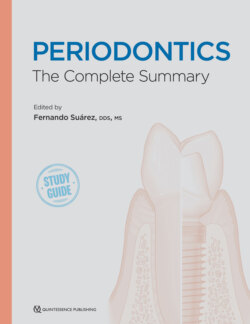Читать книгу Periodontics - Fernando Suarez - Страница 17
На сайте Литреса книга снята с продажи.
Attached gingiva
ОглавлениеAttached to the tooth and/or alveolar bone, the attached gingiva is delimited by the gingival groove at the coronal end and the mucogingival junction at the apical end. In healthy conditions, it also presents with a coral pink color. A morphologic characteristic of the attached gingiva is the stippling or orange peel appearance. The stippling corresponds to small epithelial ridges and is developed in areas of high keratinization. When the attached gingiva is inflamed, it loses the superficial stippling, and the color turns to a darker red.15,17,18
The mucogingival junction, which is the interphase between the attached gingiva and the oral mucosa, is located between 3 to 5 mm apical to the alveolar crest, and it has been shown to be stable over the years in reference to the base of the mandible or floor of the nose. Consequently, an increase in attached gingiva with age has been associated with the continuous eruption of the dentition.19,20 The dimensions of the attached gingiva have been investigated in classic studies by Bowers21 and Voigt et al.22 In the maxilla, the sites with the greatest width of attached gingiva are the central and lateral incisors. There is a decrease in canines and first premolars, and a slight increase over the second premolar and molar locations. In the mandible, the incisors also present with the greatest amount of attached gingiva with a sharp decrease around the canines and first premolars. At the second premolar site, the attached gingiva increases, and a decrease at the mandibular molar area is also observed. On the lingual aspect, the molar area presents with the greatest attached gingiva followed by premolars, incisors, and canines.
Based on the location and microscopic appearance, the gingival epithelium can be classified into three types: oral, sulcular, and junctional epithelium.
